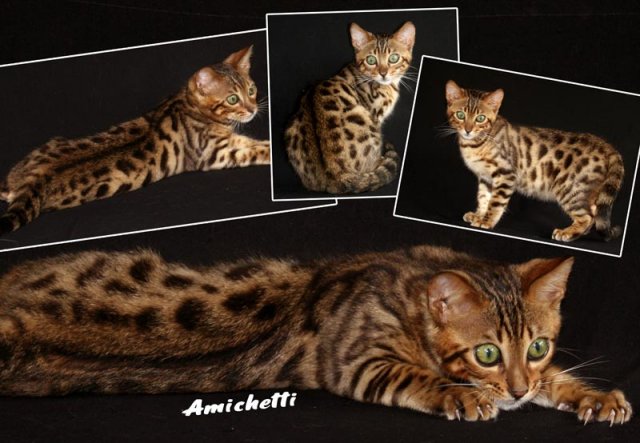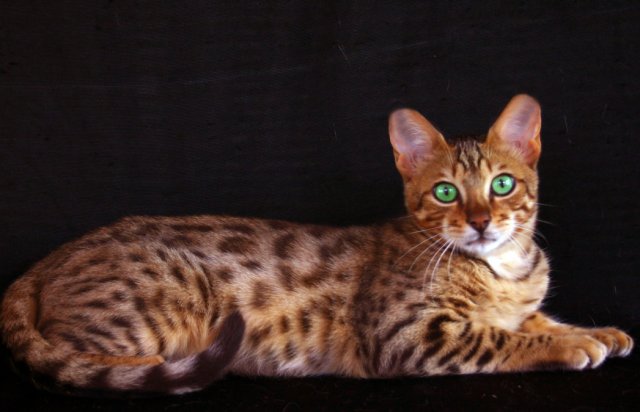Gatos
Raças de Gatos
Facebook https://www.facebook.com/gatilamicats.petclube
Contato: petclube.info@gmail.com / amichettibully@gmail.com
Original Ami cat Bengals are home cattery located a stones throw from Juquitiba, paradise Rain Forest- Brasil. We are in love with our Bengals as well as our Domestic cats. Our Bengals, however, have become a passion. These cats are an amazing animal of exceptional intellect and an uncanny ability to think problems through and find solutions. They are talkitive and will do a pretty darn good job of telling you what they want. They are very athletic and are a joy to watch.
I know, your thinking "all kittens are.." and they are, but the Bengal takes intelligence and play to an entirely different level.
We are committed to breeding quality Bengals with great bloodlines, superior temperament, health and beauty.
Our kittens are raised underfoot in our own living room with all our family around, including other cats and ours bullies dogs. They are handled everyday to ensure great socialization and extremely friendly and loving personalities.
We do screen each potential new home to ensure our babies go to a great forever home. Each owner will recieve a great deal of information regarding their new kitten as well as having unlimited access to us and our network of breeders for information throughout the life of the cat. All kittens are health guaranteed and have had their first vaccinations and worming.
For a great deal of first hand information about Bengal kittens and Amicat Bengals click hereThe Bengal may look like a wild cat, but breeders insist that the Bengal is as lovably friendly and docile as any full-blooded domestic cat. Fanciers describe Bengals as playful, gregarious, and energetic cats that have a generous dose of feline curiosity and that want to be involved with their family. Not intimidated by water, they will sometimes join their family for a swim, as long as it's on their terms.
Although show-quality cats must be four generations away (F4) from the leopard cat to be shown, previous generations of Bengals are placed as pets; therefore, it's important to know what you're getting when acquiring a Bengal. Before getting a second generation (F2) or third generation (F3) Bengal, be sure that the cat is free of temperament problems.
Original Bengal Cat Breed Traits
The Bengal's spots are aligned horizontally rather than in random or tabby configuration. Rosettes formed in a part-circle around a redder center is the preferred look. Emphasis is put on the contrast between the spots and the background color; the edges should be sharp and pattern distinct for a show-quality cat. In the marbled pattern, the markings are derived from the classic tabby gene, but the overall look is random, giving the impression of marble.
Bengals often possess a 'glitter gene' that gives the fur an iridescent glow, as if covered with warm frost. Three recessive coat variations have been developed: the snow leopard, the marbled, and the snow marbled. These types are still quite rare.
Interested in the history of the Bengal cat breed?
The Bengal breed originated as a human-made hybrid of the Asian leopard cat and the domestic cat. The leopard cat (Felis bengalensis ) is a cat-sized inhabitant of southern Asia and is thought to be one of the closest of the modern undomesticated cat species to the ancient common ancestor of the cat family.
The leopard cat looks very much like a domestic cat, except for the larger, snapping eyes, pronounced whisker pads, longer legs, and brilliant leopard markings. He looks, in fact, like a miniature leopard. The Bengal began his journey toward becoming a recognized breed in 1963 when breeder Jean Mill of Covina, California, bought a female leopard cat from a pet store. At that time, leopard cats could be purchased in the United States, although today it's illegal to sell them. She wasn't trying to create a new breed of cat, she just wanted a unique pet.
After several years, Mill thought the cat looked lonely, so she put a male domestic cat in the cat's cage to keep her company. She wasn't expecting a romantic relationship, but to Mill's surprise, in 1965 her leopard cat produced a litter.
Only one kitten from the litter survived, a female hybrid that Mill named Kin-Kin. Mill contacted Cornell University College of Veterinary Medicine in Ithaca, New York, for advice on how to handle the hybrid, and was told that Kin-Kin was probably sterile. That, also, proved false. Kin-Kin grew up, mated with her father, and produced two kittens. One was all black and had inherited the wild leopard cat temperament, it refused to let anyone near it. The other, a spotted male, inherited the sweet disposition of a domestic. After some consideration, Mill decided that creating a crossbred breed would benefit the plight of the leopard cats. Mill was dismayed by the plight of orphaned leopard cat cubs taken by hunters and sold to American pet stores. The cats generally ended up in zoos when the cubs grew to adulthood and reverted to their wild ways. Mill wanted to provide the American market with an acceptable spotted substitute.
In the first crossings of leopard cat to Domestic Shorthair, the male kittens were infertile, as is the case with many hybrids. The females were usually fertile as were the male kittens in subsequent generations. However, many of those first hybrid kittens grew up to be nervous cats of uncertain temperament, similar to their wild relatives. It was only after the cats were several generations away from the leopard cat that the Bengal's temperament became more predictable.
 Moderno Gatil BENGAL Ami cat Original com importações novas USA, Malasia, Indonésia e Inglaterra.
Moderno Gatil BENGAL Ami cat Original com importações novas USA, Malasia, Indonésia e Inglaterra.
Filhotes de Gato Gigante Maine Coon Ragdoll Bengal Persa Exótico
Mini Leopardo, MINI TIGRE, Mini Oncinha, Bengal Original Ami cats
Original bengal petclube Cattery F55 11 984854545 {youtube}a0IHjuZQLDU{/youtube}
The standard for the Bengal, unlike other cat breeds, includes a description of the cat's ideal temperament, describing him as confident, alert, curious, and friendly. Any sign of definite challenge disqualifies the cat in order to prevent temperament problems from being perpetuated in the breeding stock. IPC, TICA requires that show cats be bred Bengal to Bengal for at least four generations to ensure a docile temperament.
O petclube ami cats é um website dedicado a conteúdo sobre os gatos, estes são uns dos animais de estimação mais populares. Aprenda a cuidar do seu fato, a manter o seu gato saudável e feliz.
No nosso website pode também conhecer algumas das raças de gatos mais famosas em todo o mundo.
TV PETCLUBE GATIL AMI cat petclube cattery
Assista agora vídeos divertidos de Maine Coon e Bengal, o mini leopardo original do Gatil petclube cats
Original bengal petclube Cattery F55 11 984854545 {youtube}a0IHjuZQLDU{/youtube}Sítio Caritas- Paraíso Ecológico- uma forma sustentável de Viver.
Agende uma agradável visita e faça belo passeio em meio ao
nosso santuário ecológico com a Mata Atlântica totalmente preservada.
F:11 98485 4545 hc / 4684 1047 hc
RAÇA Bengal sustentabilidade e Natureza
 A grande vantagem do desenvolvimento da raça de gato mimi leopardo, é permitir que as pessoas tenham em casa um lindo gato de aparência selvagem e, conseqüentemente, diminuir o comércio ilegal de espécimes nativos.
A grande vantagem do desenvolvimento da raça de gato mimi leopardo, é permitir que as pessoas tenham em casa um lindo gato de aparência selvagem e, conseqüentemente, diminuir o comércio ilegal de espécimes nativos.
Os Bengal AMICATS são os gatos perfeitos para satisfazer o desejo de várias pessoas de ter e conviver com um exótico felino pintado, exatamente como um leopardo.
Os Bengals são extremamente exóticos, muito inteligentes, confiantes, alertas, ativos e amigáveis.
É impossível não se encantar com esses "mini-leopardos" de pelagem curta, espessa, luxuosa e extremamente suave ao toque

Campeão Amicats obteve excelente resultado com os renomados juízes Leandro Dallegrave- Brasil e Nini Phalempim-Belgica, sendo considerado o Best in Show com mais de sessenta gatos de várias raças.
Com as atuais importações de gato da raça bengal do gatil AMICAT´S, imprimimos mais tipicidade e variação genética no Bengal na terra brasilis.
Assista agora bengal Amicat´s brincando
- LINKS INTERESSANTES SOBRE A RAÇA DE GATO BENGAL
- Bengal Ami cats Original Novas Importações Rosetas Lindas
- Porque queremos um filhote de Gato Bengal Original
- BENGAL Original Petclube Ami Cat Gato selvagem e gato doméstico
- Gatos ajudam pessoas a serem mais felizes e alegres conheça o bengal original
- Petclube bengal Cat Estrutura Ecológica Rio de janeiro e São Paulo
